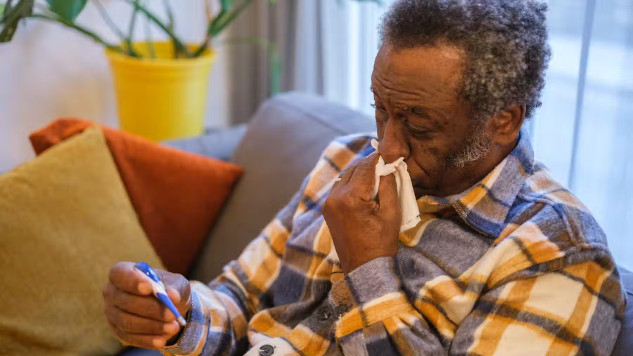
Antibiotic resistance occurs when a microorganism changes and no longer responds to an antibiotic that was previously effective. It’s associated with poorer outcomes, a greater chance of death and higher health-care costs.
In Australia, antibiotic resistance means some patients are admitted to hospital because oral antibiotics are no longer effective and they need to receive intravenous therapy via a drip.
Antibiotic resistance is rising to high levels in certain parts of the world. Some hospitals have to consider whether it’s even viable to treat cancers or perform surgery due to the risk of antibiotic-resistant infections.
Australia is one of the highest users of antibiotics in the developed world. We need to use this precious resource wisely, or we risk a future where a simple infection could kill you because there isn’t an effective antibiotic.
When should antibiotics not be used?
Antibiotics only work for some infections. They work against bacteria but don’t treat infections caused by viruses.
Most community acquired infections, even those caused by bacteria, are likely to get better without antibiotics.
Taking an antibiotic when you don’t need it won’t make you feel better or recover sooner. But it can increase your chance of side effects like nausea and diarrhoea.
Some people think green mucus (or snot) is a sign of bacterial infection, requiring antibiotics. But it’s actually a sign your immune system is working to fight your infection.
If you wait, you’ll often get better
Clinical practice guidelines for antibiotic use aim to ensure patients receive antibiotics when appropriate. Yet 40% of GPs say they prescribe antibiotics to meet patient expectations. And one in five patients expect antibiotics for respiratory infections.
It can be difficult for doctors to decide if a patient has a viral respiratory infection or are at an early stage of serious bacterial infection, particularly in children. One option is to “watch and wait” and ask patients to return if there is clinical deterioration.
An alternative is to prescribe an antibiotic but advise the patient to not have it dispensed unless specific symptoms occur. This can reduce antibiotic use by 50% with no decrease in patient satisfaction, and no increase in complication rates.
Sometimes antibiotics are life-savers
For some people – particularly those with a weakened immune system – a simple infection can become more serious.
Patients with life-threatening suspected infections should receive an appropriate antibiotic immediately. This includes serious infections such as bacterial meningitis (infection of the membranes surrounding the brain) and sepsis (which can lead to organ failure and even death).
When else might antibiotics be used?
Antibiotics are sometimes used to prevent infections in patients who are undergoing surgery and are at significant risk of infection, such as those undergoing bowel resection. These patients will generally receive a single dose before the procedure.
Antibiotics may also be given to patients undergoing chemotherapy for solid organ cancers (of the breast or prostate, for example), if they are at high risk of infection.
While most sore throats are caused by a virus and usually resolve on their own, some high risk patients with a bacterial strep A infection which can cause “scarlet fever” are given antibiotics to prevent a more serious infection like acute rheumatic fever.
How long is a course of antibiotics?
The recommended duration of a course of antibiotics depends on the type of infection, the likely cause, where it is in your body and how effective the antibiotics are at killing the bacteria.
In the past, courses were largely arbitrary and based on assumptions that antibiotics should be taken for long enough to eliminate the infecting bacteria.
More recent research does not support this and shorter courses are nearly always as effective as longer ones, particularly for community acquired respiratory infections.
For community acquired pneumonia, for example, research shows a three- to five-day course of antibiotics is at least as effective as a seven- to 14-day course.
The “take until all finished” approach is no longer recommended, as the longer the antibiotic exposure, the greater the chance the bacteria will develop resistance.
However, for infections where it is more difficult to eradicate the bacteria, such as tuberculosis and bone infections, a combination of antibiotics for many months is usually required.
What if your infection is drug-resistant?
You may have an antibiotic-resistant infection if you don’t get better after treatment with standard antibiotics.
Your clinician will collect samples for lab testing if they suspect you have antibiotic-resistant infection, based on your travel history (especially if you’ve been hospitalised in a country with high rates of antibiotic resistance) and if you’ve had a recent course of antibiotics that hasn’t cleared your infection.
Antibiotic-resistant infections are managed by prescribing broad-spectrum antibiotics. These are like a sledgehammer, wiping out many different species of bacteria. (Narrow-spectrum antibiotics conversely can be thought of as a scalpel, more targeted and only affecting one or two kinds of bacteria.)
Broad-spectrum antibiotics are usually more expensive and come with more severe side effects.
What can patients do?
Decisions about antibiotic prescriptions should be made using shared decision aids, where patients and prescribers discuss the risks and benefits of antibiotics for conditions like a sore throat, middle ear infection or acute bronchitis.
Consider asking your doctor questions such as:
- do we need to test the cause of my infection?
- how long should my recovery take?
- what are the risks and benefits of me taking antibiotics?
- will the antibiotic affect my regular medicines?
- how should I take the antibiotic (how often, for how long)?
Other ways to fight antibiotic resistance include:
- returning leftover antibiotics to a pharmacy for safe disposal
- never consuming leftover antibiotics or giving them to anyone else
- not keeping prescription repeats for antibiotics “in case” you become sick again
- asking your doctor or pharmacist what you can do to feel better and ease your symptoms rather than asking for antibiotics.
Minyon Avent, Antimicrobial Stewardship Pharmacist, The University of Queensland; Fiona Doukas, PhD candidate, University of Sydney, and Kristin Xenos, Research Assistant, College of Health, Medicine and Wellbeing, School of Biomedical Science and Pharmacy, University of Newcastle
This article is republished from The Conversation under a Creative Commons license. Read the original article.
Related Books:
The Body Keeps the Score: Brain Mind and Body in the Healing of Trauma
by Bessel van der Kolk
This book explores the connections between trauma and physical and mental health, offering insights and strategies for healing and recovery.
Click for more info or to order
Breath: The New Science of a Lost Art
by James Nestor
This book explores the science and practice of breathing, offering insights and techniques for improving physical and mental health.
Click for more info or to order
The Plant Paradox: The Hidden Dangers in "Healthy" Foods That Cause Disease and Weight Gain
by Steven R. Gundry
This book explores the links between diet, health, and disease, offering insights and strategies for improving overall health and wellness.
Click for more info or to order
The Immunity Code: The New Paradigm for Real Health and Radical Anti-Aging
by Joel Greene
This book offers a new perspective on health and immunity, drawing on principles of epigenetics and offering insights and strategies for optimizing health and aging.
Click for more info or to order
The Complete Guide to Fasting: Heal Your Body Through Intermittent, Alternate-Day, and Extended Fasting
by Dr. Jason Fung and Jimmy Moore
This book explores the science and practice of fasting offering insights and strategies for improving overall health and wellness.






















